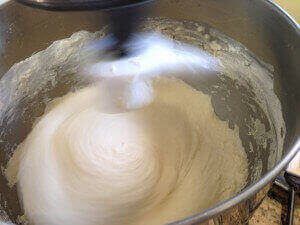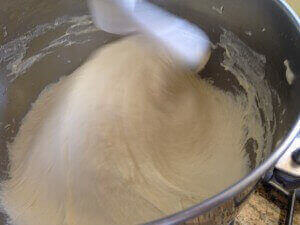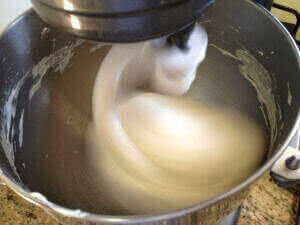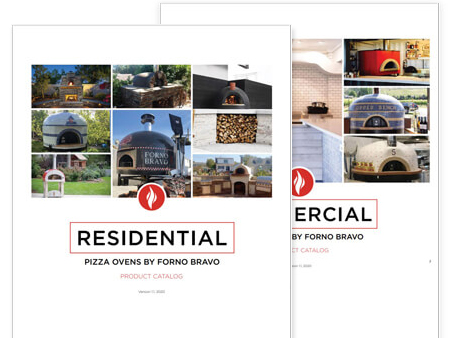Mixing High Hydration Dough
May 21, 2012Posted by Forno BravoI made 80% hydration baguette’s, and was reminded just how much longer (and a little faster) you need mix the dough to build the strands of gluten and develop the bread’s structure. That statement marks roughly the end of my technical knowledge on the science of web dough—thought I want to do some more research in order to understand why this is true.
From this sequence of photos, you can see the dough go from being not much more than batter, to nice thin strands of gluten developing, to the entire mixtures pulling from the sides of the mixing bowl to shape a true dough ball with a wonderful, silky texture.
Here is the recipe:
1 kg of Trader Joe’s white all purpose flour
10 grams of yeast
20 grams of salt
800 grams of ice water
Mixing took 13-15 minutes, including 3-4 minutes in the middle with my KitchenAid stand mixer running at a high speed (4 or 5). I bulk fermented the dough for a couple of hours before pushing out all of the air bubbles and shaping baguettes.
I ended up making some nice baguettes in my Presto pizza oven.
One last note. The Forno Bravo “perfect pizza dough” by weight recipe that we use in all of our eBooks does not call for you to proof your yeast in any way—we don’t add sugar to get it started, we don’t add warm water, and we don’t mix it on the side. Modern yeast is simply good enough to work without any of these extra steps.
“Ah, but does it always work?” you might be asking be asking yourself. If fact, we get a reasonable number of questions by phone and email, asking us if that really works. The answer is a resounding yes!
Think of it this way. In this recipe, I added the yeast directly to the flour (with no sugar or honey, and no separate proofing), and then I proceeded to dump ice water on top of it. Ice water, which is pretty much the opposite of proofing the yeast in warm water. And it worked great.
So my advice is to skip the yeast proofing step, and invest that time is very accurate weighing of your ingredients. You will come out ahead on time, and your bread and pizza dough will be much better!








